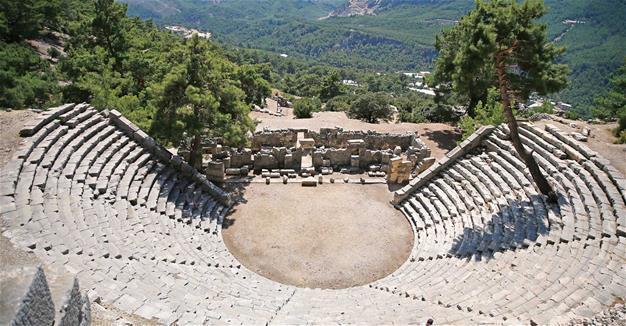Ruins of ancient villa found in Antalya
ANTALYA
 Excavations in the ancient city of Arykanda in the southern province of Antalya’s Finike district, have unearthed the ruins of a 1,700 year-old villa.
Excavations in the ancient city of Arykanda in the southern province of Antalya’s Finike district, have unearthed the ruins of a 1,700 year-old villa.The findings in the ancient city show the importance of the city in the ancient times, said the archaeologists.
The head of excavations Associate Professor Macit Tekinalp said Arykanda was built on terraces because of its topographic features.
He said public buildings were also built on terraces and Arykanda bears the name of a big rock in its skirt, meaning “the places next to high rock.”
Most of the ancient cities bear the name of their founders but Arykanda was given the name of the place, said Tekinalp, adding excavations had been ongoing in the region for 47 years.
He said Arykanda was mentioned in some resources as the place where “lotus-eaters” lived. “There are six baths in this ancient city. The expression ‘lotus-eaters’ may have been used because of these baths. This city is on the skirt of a mountain, which is hard to reach. We do not have too much evidence that life was luxurious here,” he added.
Tekinalp said Arykanda was not on the route of Alexander the Great and did not see many wars, adding the city used all the advantages of being on a main road.
Villa from 1,700 years ago
Tekinalp said a villa structure from 435 A.D. was unearthed during excavations and the villa is thought to have been destroyed by a fire but it gives important clues about its period.
“We think the villa collapsed during a fire in 435 A.D. It gives us important archaeological data. The ancient cities that went through fire or earthquake are very important to us. Because we can reach the tools people were not able to take. We also found the name of the person who owned this villa on a mosaic in the ground. His name is Pierus, who we think had a big family. The structure has eight big rooms,” he said.
Tekinalp also said the villa had a view overlooking the city and one of the prestigious residences at the time. “There is a special bath used by Pierus and his family. They also used the bath commercially by renting it. The villa turned to two-room houses in the following years. There is also a pool in the courtyard of the villa and it has a view. These findings shed light on the life of an aristocrat in the fourth century,” he said.
According to Tekinalp, the second floor of the villa was made of wood and mosaics were processed on it and they had seen it for the first time during the excavation.
Field of tableland
Tekinalp said they found the ruins of three more villas in the ancient city and that their owners were privileged people in the late Roman era.
He depicted the ancient city of Arykanda as established on a valley in a forest whose most important income was forest products and trade.
Although it is a mid-size settlement, there were six baths, Tekinalp said.
“Baths were the centers of attraction in a city. People on the coastline came to this city to cool off. This region served as a tableland. We think it was popular in local tourism. Otherwise, we cannot explain the existence of six baths. The population is not enough for six baths. The city is the most important connection road between the coast and Anatolian plateau in the central Lycian region. People on this route accommodated there,” he said.
Tekinalp also said there were intense relations between Egypt and Lycia in the Hellenistic era and they had also unearthed findings related to the Egyptian faith.
















